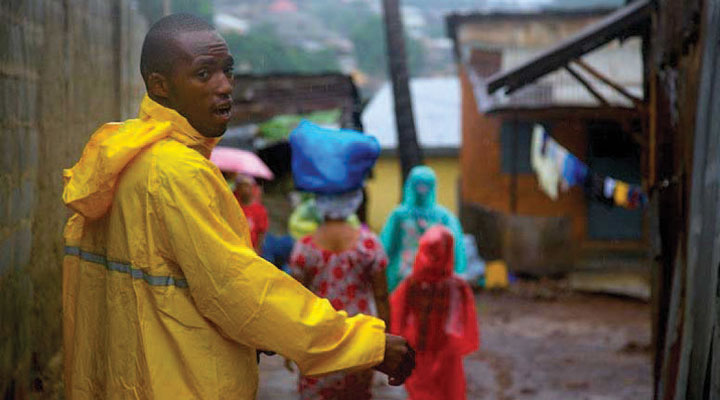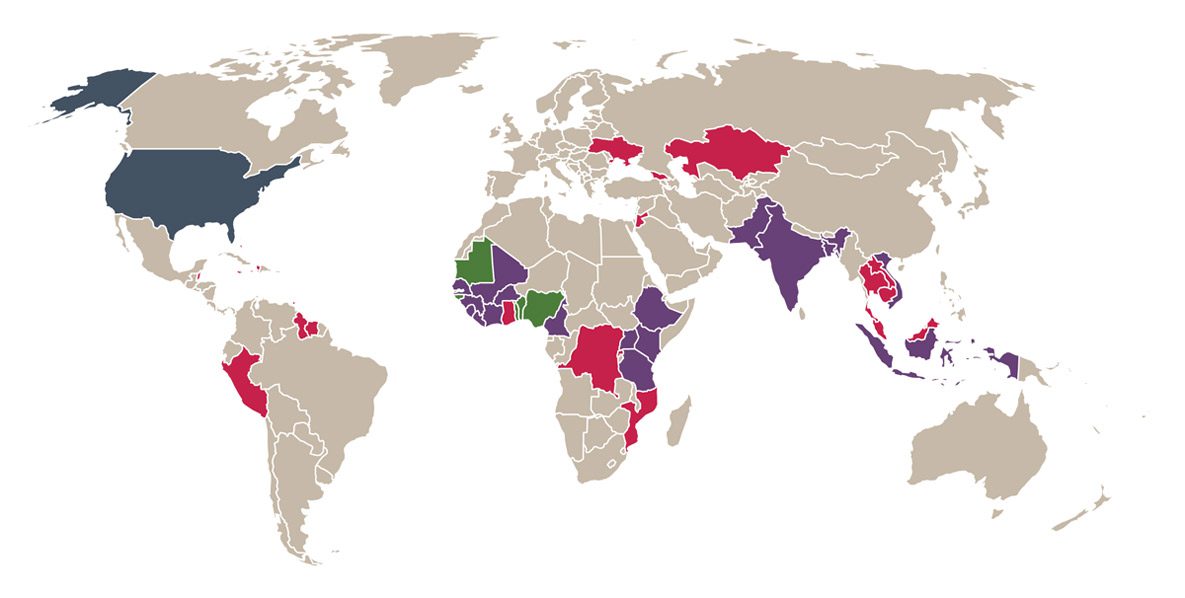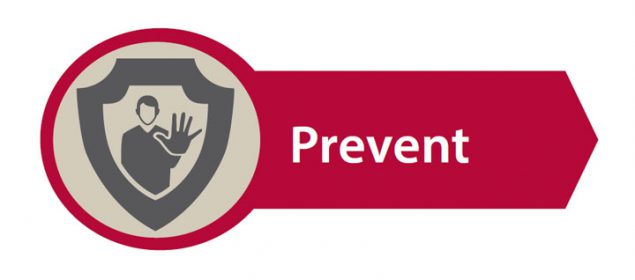Stopping outbreaks at the source. Protecting America’s future.
CDC works 24/7 to protect America’s health security by fighting dangerous disease threats around the world. We are the frontline responders, containing outbreaks overseas so they do not reach our shores.
What Is the Global Health Security Agenda?

Guinea infection prevention – Community Health Officer Mr. Camara (Photo credit: Patrick Adams, RTI International)
The Global Health Security Agenda (GHSA), launched in 2014, is a global effort to strengthen the world’s ability to prevent, detect, and respond to infectious disease threats, whether they are naturally occurring, accidentally or intentionally released. The purpose of the GHSA is to accelerate progress toward achievement of the International Health Regulations (2005) and strengthen global public health capacities within 31 countries and the Caribbean. The Centers for Disease Control and Prevention (CDC) plays a leading role in the implementation of the GHSA for the United States (U.S.). As part of the broader U.S. government engagement, CDC is committed to working with these countries to strengthen their capabilities to identify, track, and stop outbreaks or other public health emergencies.
Why Does It Matter?

Disease Detectives in Nigeria – Pertussis (Photo credit: Visa Tyakaray)
More than 70% of the world remains underprepared to prevent, detect, and respond to a public health emergency.1Through GHSA, CDC works with countries to strengthen public health systems and contain outbreaks at the source, before they spread into regional epidemics or global pandemics. Public health threats, health emergencies, and infectious diseases do not recognize or respect borders. Effective and functional public health systems in all countries reduce the risk and opportunity for health threats to affect the U.S.
GHSA builds capabilities to achieve 11 specific Action Package targets:
Across 3 Priority Areas |To Achieve 3 Critical Health Security Impact
Global Health Security Agenda Countries Supported by CDC

World map depicting Ebola Preparedness Countries and GHSA Phase I and II countries shaded by category.

GHSA Phase I (in purple): Bangladesh, Liberia, Burkina Faso, Mali, Cameroon, Pakistan, Côte d’Ivoire, Senegal, Guinea, Sierra Leone, Ethiopia, Tanzania, India, Uganda, Indonesia, Vietnam, and Kenya

GHSA Phase II (in red): Cambodia, Democratic Republic of Congo, Georgia, Ghana, Haiti, Jordan, Kazakhstan, Laos, Malaysia, Mozambique, Peru, Rwanda, Thailand, Ukraine, and CARICOM*

Ebola Preparedness Countries (in green): Benin, Gambia, Guinea-Bissau, Mauritania, Nigeria, and Togo
*Caribbean Community (CARICOM) is an organization of 15 Caribbean nations and dependencies. GHSA Phase II will have a regional focus.
Why CDC?
Beginning with smallpox eradication in 1980, CDC has worked around the world to protect the health of the American people as the world’s preeminent U.S. public health agency. To effectively protect American health, CDC established itself as a leader and partner in the identification, control, elimination, and eradication of infectious diseases, recognizing that global health security is a critical component of America’s national security.
CDC’s unique scientific expertise, international network, and decades of domestic and international experience have proven to be essential to the success of the GHSA. At CDC, we are focused on bringing solutions to global health challenges. We use the best available science to develop novel approaches for public health action in domestic and international settings. We apply lessons learned from international programs such as the President’s Emergency Plan for AIDS Relief (PEPFAR), the President’s Malaria Initiative, global immunization, and previous emergency responses to develop evidence-based approaches that protect Americans from global infectious disease threats.
CDC efforts play a critical role in the identification and containment of the world’s most dangerous emerging global health threats—including deadly diseases like SARS, MERS, Ebola, and Zika. CDC protects Americans by actively tracking and monitoring potential threats around the world, developing new technologies to detect dangerous diseases, and remaining ever ready to respond when disaster strikes.

FETP residents from Benin and Togo share information about a Lassa Fever outbreak (Photo credit: Rebecca Merrill, Global Border Health Team/NCEZID)
Where Is CDC Working?
Under the GHSA, the U.S. is committed to partner with:
- 17 Phase I countries that receive financial support and technical assistance from CDC
- 14 Phase II countries that receive only technical assistance from CDC
How Does CDC Do It?
CDC works bilaterally or directly with national governments, non-governmental organizations, academia, multilateral organizations, the private sector, and other stakeholders to build core public health infrastructure that may be used to effectively identify and combat infectious disease outbreaks and respond to epidemics. CDC leadership and expertise have been instrumental in focusing a multisectoral and multinational coalition across 11 technical areas known as GHSA Action Packages that build core public health capacities in partner countries. CDC’s focus on GHSA Action Packages such as disease surveillance, laboratory systems, workforce development, and emergency management have already resulted in measurable progress.
What Is CDC’s Impact?
When it comes to protecting the public’s health, the world must be prepared for both the known and unknown threats. CDC stands ready to prevent, detect, and respond to the next disease outbreak by taking the lead in working with countries and partners to build a world safer from disease threats. This year alone, CDC’s global health protection worked helped contain the spread of Ebola in Equateur Province in the Northwest Democratic Republic of Congo, meningitis in Liberia, Marburg virus in Uganda, and other threats too numerous to list. CDC’s global work protects Americans both at home and abroad and ensures that health threats do not reach U.S. borders.


